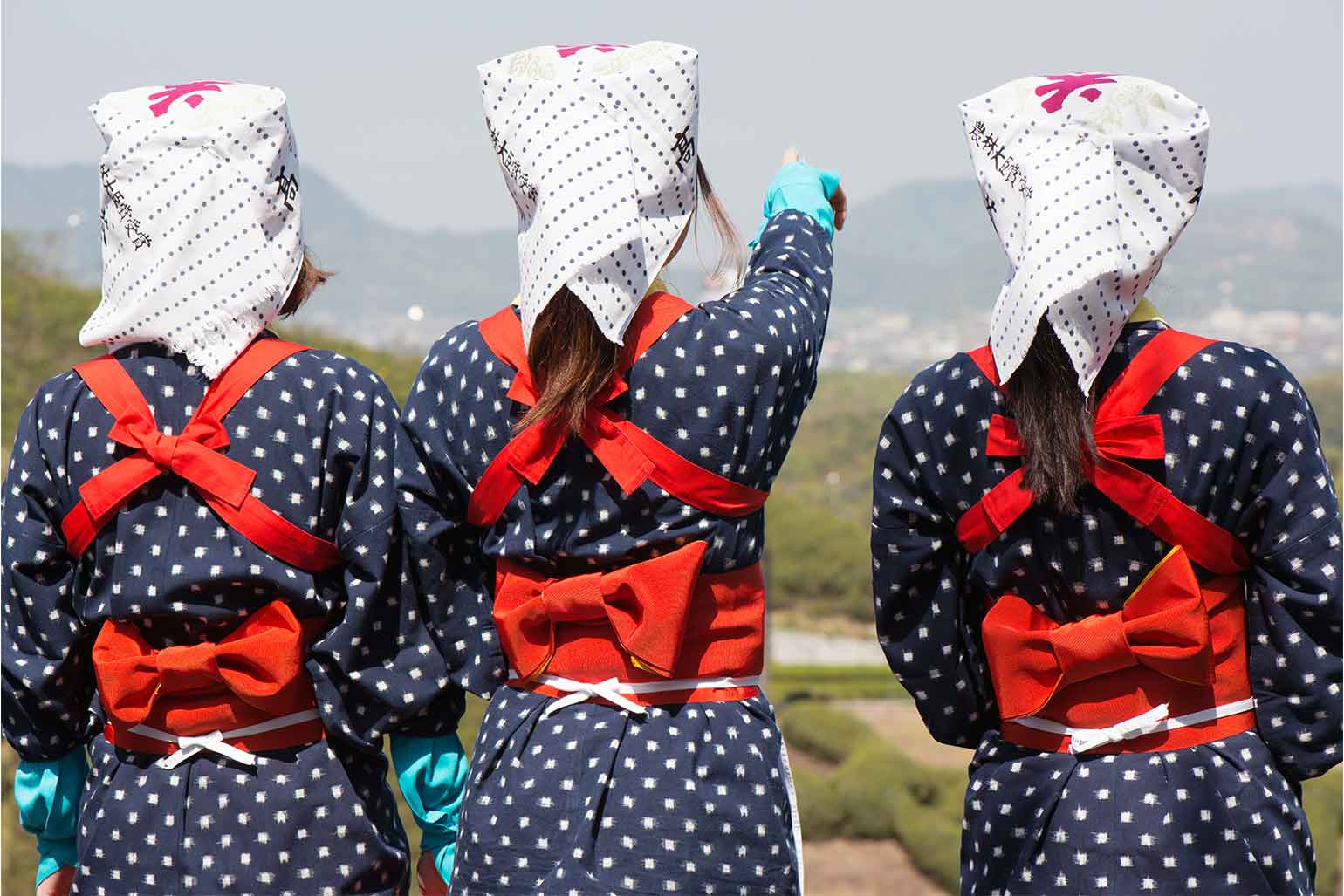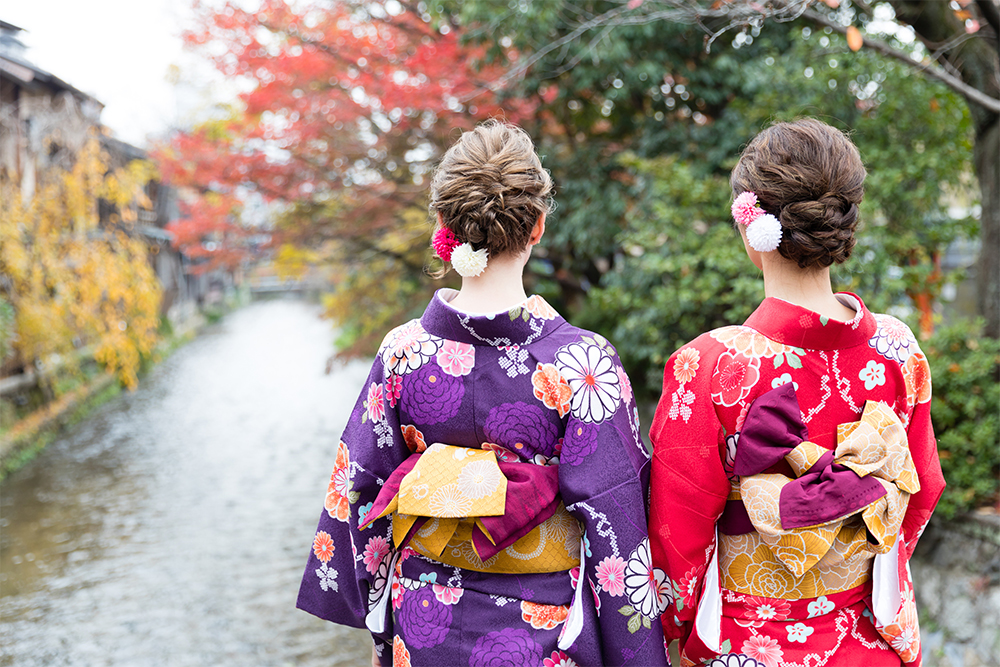The basics of culture are “clothing”, “food” and “housing”. Speaking of “clothes” in Japan, the kimono is greatly traditional. Though we want to say that… Unfortunately, even Japanese people are becoming less familiar with it in everyday life. To wear kimono, the skill of dressing in it is required. In other words, it is beautiful for the purpose of viewing and if worn correctly use the entire functionality of the kimono, but there are few Japanese people who know it. Originally, kimono was a very functional garment, the basic construction very simple. The climate in Japan is warm and humid. Summer is hot and humid while winter is cold and dry. Some regions of Japan are as hot and humid as subtropical regions, and some are the world’s leading heavy snowfall areas. It’s a clothing that can handle a wide range of geographical features. Also, even though “dressing” is not familiar, it’s become much easier to wear it, due to the lacking public knowledge of its proper wear. However, changed have Japanese lifestyle. If “food” and “housing” change, then “clothing” has naturally also moved to that. We think that it would be nice if the kimono came back into daily life. Isn’t it like Japanese like “Haori” or “Hakama”? We feel that it is more attractive to when one wears it in the streets, especially against the cityscape. The materials will use current technology… Well, it might be hard to get back into the hairstyle… Kimono is quite popular with overseas visitors. It is widely recognized as one of Japan’s characteristic and attractive culture points. This is very appreciated. We think there are still many aspects of our culture that Japanese people are not aware of or have forgotten. The overseas people say that it is “excellent” and that reminds us again. Isn’t it a wonderful place for cross-cultural exchange? So… We would be happy if you noticed more and more. And we think it would be great if it leads to an understanding of each other’s culture. This is one of the big wishes of this site.
We would like to also talk about Yukata, one of kimono that can be enjoyed easily. Yukata is a summer kimono. Even at festivals and fireworks, Japanese people wear it because it is so traditional. Yukata is packed with the basics of wearing kimono in Japan. How to tie your hair, how to fasten a band, how to walk in sandals, etc. About a few days before the summer, reasonable priced yukatas will be lined up in the store, so we think it’s fun to look into purchasing one. Of course, it is also recommended to peek into specialty stores. Please ask about “dressing.” Most of storeowners know how to dress it, and you can wear yukatas on the spot. If it is simpler, it may be offered at lodging facilities such as inns and hotels. It may be a little restricting at first, but once you get used to it you will find that it is very functional clothing. This is an aspect of culture that you must try once in order to truly understand it.
In addition, it seems that the trick to dress kimono neatly and correctly is posture. Even if your standing posture is correct, it will eventually collapse once being dressed in the kimono. Then, you will know how good and bad your posture is. Once you wear it, your posture will be improved. What do you think? There may be some people who are interested in kimonos because of this point.
Please try it by all means.
Tasuki(Sash)

After the Meiji Restoration, Japanese clothing culture changed from Japanese clothes, mainly “kimono”, to some kind of Western clothes. As our daily lives became more Westernized, Western clothing was probably more suitable in many ways. However, Western clothing was still expensive, and it was not until after World War II that Westernized clothing became widely available to the general public. Western clothes culture was only for the high society and those who held official positions. Well, you can see that one of the biggest differences between a “kimono” and a Western-style clothing is the shape of the sleeves. The part that hangs down is called “tamoto,” and it’s very characteristic, isn’t it? It should be that the unique shape of the sleeves was one of the main charms of “kimono”, its beauty and its practicality in terms of structure. But… It seems to have been incompatible with the Westernization of lifestyles that was being advanced at the time. That charming sleeve part would have been inconvenient to get caught on something or dragged around… Yes yes, with a shape like that, it is not hard to imagine that it would be quite inconvenient to get used to it. So how did they handle those fluttery sleeves and keep them out of the way until then…? To solve this problem, a piece of equipment called a “Tasuki” was used. Some of you may have seen it in movies or comics. It is a string-like item that is used to pull up the hanging sleeve part from the shoulder to the underarm. People in those days usually carried that “Tasuki” string with them to use for that purpose. When they were doing some kind of work, they used that string to keep that hanging sleeve part out of the way. As long as it was a long, thin, sturdy string, it could be made of any kind of material, including fabric or rope. It’s not that hard to carry, and it’s easy to put on and take off, so it must be an excellent piece of item. When wearing “kimono”, it is one of the essential skills to be able to attach the “Tasuki” quickly and correctly. We hope you will keep this in mind.




_op.png)
_001.png)
_002.png)
_003.png)
_004.png)
_005.png)
_006.png)
_007.png)
_008.png)
